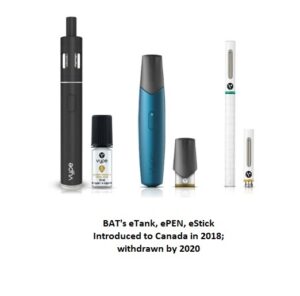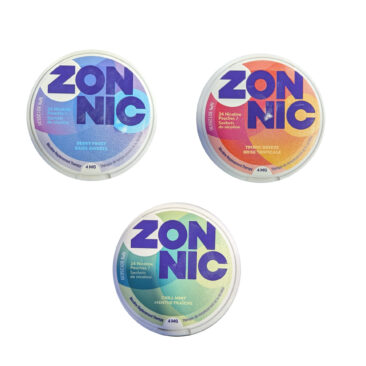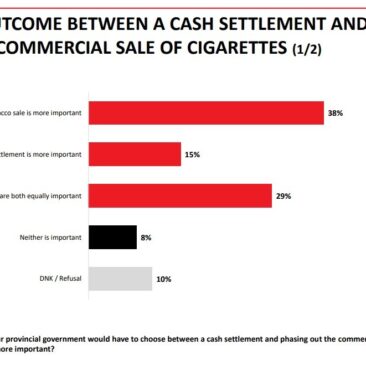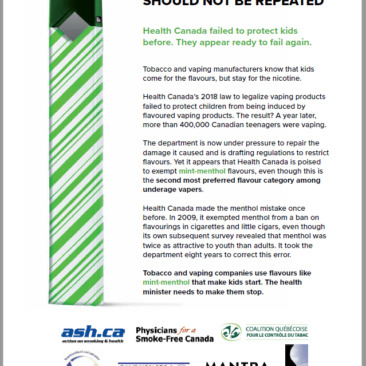This post provides an update on disposable electronic nicotine devices in Canada, identifies some important information gaps in Canada and notes key developments with respect to these single-use plastic products in other countries.

Canada’s largest tobacco companies are intensifying their sales of disposable e-cigs.
Last month, the Canadian subsidiary of British American Tobacco (Imperial Tobacco Canada Ltd), introduced a third version of its disposable vaping device, VUSE GO. The VUSE GO EDITION 5000 delivers five times as much nicotine as the original 500-puff VUSE GO and more than three times as much as the 1,500 puff VUSE GO XL.
Unlike cigarettes, vaping products quickly change
 In the 5 years since vaping products were legalized in Canada, BAT has revamped its product offerings three times. In the summer of 2018, the company sold two devices: the refillable eTank system and liquids and the eStick cig-a-like. Within a few months, facing stiff competition from JUUL, it introduced the ePEN pod system. About 16 months later, in January 2020, BAT introduced the ePOD system, which was designed to deliver salt nicotine. By the following year, only the ePOD remained for sale.
In the 5 years since vaping products were legalized in Canada, BAT has revamped its product offerings three times. In the summer of 2018, the company sold two devices: the refillable eTank system and liquids and the eStick cig-a-like. Within a few months, facing stiff competition from JUUL, it introduced the ePEN pod system. About 16 months later, in January 2020, BAT introduced the ePOD system, which was designed to deliver salt nicotine. By the following year, only the ePOD remained for sale.
One other global tobacco company also sells vaping products in Canada. The Canadian subsidiary of Philip Morris International (Rothmans, Benson and Hedges) sells a pod system (VEEV ONE) and a disposable vape (VEEV NOW). The disposable has been rebranded since it was introduced last summer as VEEBA. Vaping products have been introduced and then withdrawn by other multinational tobacco companies: Imperial Brands sold BLU from December 2018 until July 2020, and Japan Tobacco International sold Logic from early 2019 until the summer of 2021.
This rapid market change contributes to the difficulties in linking specific product designs when monitoring how e-cigarettes contribute to people stopping smoking or how they recruit new nicotine users.
Disposables are being used to drive down the cost of vaping.
The VUSE GO 5000 reduces the cost of using VUSE liquids to less than one-fifth of the price charged a year ago – which was before the federal excise tax of $1 per 2 ml was applied.
Including tax, VUSE GO 5000 sells for $25.99, which makes the cost per puff just over one-half cent ($0.0052). By comparison, the cost-per-puff of the $19.99 Vuse GO XL is $0.013, for the $9.99 Vuse GO is $0.02 and for an $8 ePOD, which delivers 250 puffs, the price is $0.032.
PMI/Rothmans Benson and Hedges is also making vaping increasingly affordable — in spite of the federal excise tax. A starter kit including pod device and package of 2 pods (providing 800 puffs) now sells for $11.99 ($0.015 per puff); Individual disposable products (500 puffs) sell for $11 ($0.022 per puff), reduced to $6 each if bought in quantities ($0.012 per puff).
The companies’ use of volume discounts should raise red flags among regulators, as they facilitate sales to youth. PMI/RBH, for example, discounts each disposable unit by $5 (45%) when it is sold in bundles of 9 or 11 units. This provides a financial incentive for “legal age” customers to resell to underage users through social sources.
Regulators might also want to consider whether the company is selling some products below the price of manufacture and distribution (in order to recruit long term customers). Once the $2 excise tax is removed from the multi-pack price of VEEV NOW, this disposable device is marketed at $4 per unit.
Disposables are expanding a vaping market that was otherwise flat.
BAT is growing revenues from vaping only because of ‘s revenues from pod-systems is flat — but for disposables is growing
In October 2022, BAT pivoted to the disposable market in Canada and its other “top markets”. The results of that initiative were reported to investors earlier this spring. In the 5 countries that “represent 88% of vapour industry revenue” (US, Canada, UK, France, Germany) the revenues from pod systems were essentially flat
This spring, BAT reported to investors that disposables have not replaced the pod-based systems, but are instead expanding e-cigarette revenues in the “top 5 markets”. According to the company, sales in the US, Canada, UK, France, Germany represent 88% of the world’s vaping industry revenue. BAT reports that since 2020, revenue growth for pod systems has been essentially flat (increasing by 4%), but that the sale of disposables has driven the sector to a 30% overall increase.

From BAT’s report, it appears that those who buy disposable e-cigarettes are not the same customers who previously purchase their VUSE pod-systems or cigarettes (“very limited cannibalisation”).
Similar information for the Canadian market was reported to Ontario courts earlier this year, with “[e-cigarette] revenues growing by over 30 percent, which was driven mainly by the launch of a disposable-device.”
Disposable e-cigarettes appear to accelerate youth vaping
Just as the marketing of salt-nicotine JUUL was associated with high rates of youth vaping a few years ago, the wide accessibility of inexpensive and flavourful disposable products in England and the United States is associated with youth vaping in those countries. These products often are sold illegally (higher than permitted nicotine in England, and without FDA permission in the USA).
Data from the ITC Project survey of young adults (16 to 19) show that as young people turned to disposable e-cigarettes, the rates of use doubled from 12% to 24%. (Slides shown below were presented at the Ottawa Model Conference earlier this year, click to enlarge). The data which was presented for Canada (not shown) indicated that at the time of the survey (August 2022) Canadian youth were predominantly using pod-systems, although disposable use was growing. It is important to note, however, that this survey predated the distribution through convenience stores of disposable products sold by the large tobacco companies (VEEBA and VUSE GO).
The impact of disposables on Canadian youth is not yet known
While disposable cigarettes made by STLTH and others have been on the market for a couple of years, it was only a year ago that tobacco companies entered this market and began using their convenience store distribution system to expand availability. The impact of this is not yet known: a national survey on vaping behaviour was conducted over the Christmas-New year period in 2022-2023, but the results will not be released until later this summer.
The challenge of associating product design to youth vaping is made more challenging because Canada’s health surveillance system does not currently collect information on the brands or types of products used by children or adults. For example, the questionnaires for the Statistics Canada’s Canadian Tobacco and Nicotine Survey, and Health Canada’s Canadian Student Tobacco, Alcohol and Drugs Survey do not include important questions on strength or type of nicotine, brands, device designs or price. Information on these issues is sometimes gathered in the consumer research commissioned by the federal government.
Nor is it clear how many e-cigarettes (disposable or otherwise) are sold in Canada. Manufacturers are not required to make such information public, and firms which track sales (like ACNielsen, IRI, etc.) do not permit subscribers to their consumer tracking services to share the information. Last month Health Canada finalized reporting regulations for vaping companies, which will require them to submit sales data twice a year. The first of these reports is not due until next January. Health Canada has not yet indicated how, when or whether this information will be shared with the public or researchers.
Disposable e-cigarettes are an environmental threat
Communities and governments are increasingly concerned about vaping devices contributing to toxic plastic and electronic waste. The plastic casing, the toxins in the e-liquid residue, the lithium batteries and the heavy metals in the circuit boards all pose environmental concerns. As Canadian federal environmental officials recently acknowledged: “If these devices end up in the environment as pollution, they may be harmful to wildlife and their habitats.”
The environmental concerns are not limited to those related to littering. Throwing e-cigarettes into the regular waste stream also causes harms. As the British environmental agency, Material Focus, recently reports, such electronic waste needs to be separately recycled, but producers, importers, distributors and retailers of disposable and other forms of e-cigarettes are not currently required to do anything to ensure this happens. That company estimates that over a million a week are being binned and sent to landfill.
This month, a report commissioned by the Scottish government considered environmental impacts related to littering, unsafe disposal of their contents including lithium batteries and chemicals, as well as the impact with respect to greenhouse gas emissions and water consumption generated in their manufacture. It considered 13 categories of policy options, of which 9 were recommended for further consideration. These ranged from banning disposable devices, establishing a deposit-return system, setting design standards, requiring replaceable batteries, specific levies and better enforcement of sales to youth.
To date, at least one country has banned single use e-cigarettes (New Caledonia), and many others have expressed an interest addressing the environmental and health impact of these products. Recent actions by governments include:
- the Irish government consulting on disposable e-cigarettes (June 2023)
- the English government including disposables in its consultation on measures to reduce youth vaping (closed June 2023)
- Switzerland finalizing a higher tax on single use e-cigarettes than other e-liquids (CHF1 per ml vs CHF0.20 pr ml). (June 2023)
- the New Zealand health ministry announcing its intention to reduce the maximum allowable nicotine in disposable e-cigarettes and to require batteries to be removable (June 2023)
- the French health minister (Francois Braun) saying he was personally in favour of banning them, and that he hoped to include them in the governments upcoming tobacco strategy renewal. (May 2023)
- Australia’s health minister (Mark Butler) announcing his intention to ban disposable e-cigarettes, while allowing others to be sold under prescription. (May 2023)
- the German Bundesrat (federal council of states) calling on government to work towards banning single use e-cigarettes on the national and EU level (March 2023)
- a cross-party private members’ bill to ban disposable e-cigarettes was introduced to the U.K. House of Commons. (February 2023)
The disposable vape market is proving difficult to control
Governments which have clamped down on the e-cigarette marketing are having difficulties stopping the sale of products which they have banned.
The U.S. Food and Drug Administration has since not authorized any single-use vape for sale, and has ordered all unauthorized products off the market. Nonetheless, companies collecting data from retail store sales recently reported that there are thousands of disposable products still available.
Denmark banned flavoured vaping products in April 2022, but has since discovered that young people still have access to flavoured and higher-nicotine single use products. Some of these enforcement challenges were reported to Danish legislators, and the minister is considering further regulatory changes.
This year, information was released showing that officials in the United Kingdom have seized more than a million disposable vaping devices that contained illegally-high levels of nicotine.
Illegally imported Chinese vapes may also be illegally exported from China.
Last year the Chinese government imposed strict controls on the e-cigarette industry. The new measures included a ban on flavourings and requirements that all domestic wholesales be managed through a centralized system. The new Chinese law exempts exports from these requirements, but nonetheless requires exports comply with the laws of the importing country. On this basis, it seems that the high-nicotine exports to the U.K., for example, are a breach of both UK and Chinese health regulations.
The global tobacco treaty (the Framework Convention on Tobacco Control) does require countries to cooperate in implementing the public health measures outlined in the treaty. The treaty was drafted before the era of electronic cigarettes, and countries are divided on whether or how public approaches to e-cigarettes fit with the convention. E-cigarettes are expected to be discussed at the November 2023 Conference of the Parties, although the importance of international cooperation in controlling imports and exports does not appear to be on the agenda.











